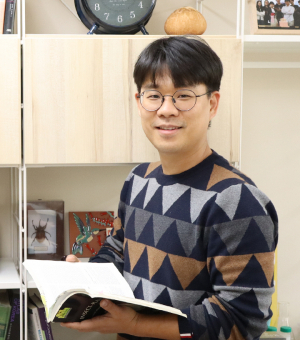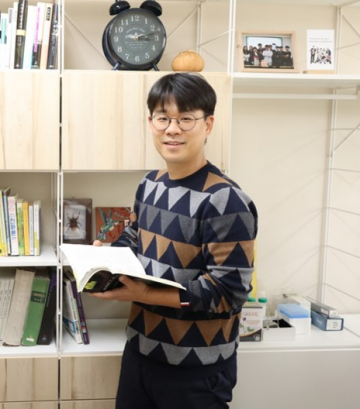Assistant Professor
Joo, Youngsung
Research
Ecology
Evolutionary Biology
Plant Sciences
A single organism also faces biotic and abiotic heterogeneity over time and space scales and these heterogeneity often increase phenotypic plasticity of organisms. Therefore, plants require to evolve plastic responses over time and space to survive under the heterogeneous environment. Ecological interactions vary on many spatial and temporal scales because ecological niche can be differentiated in different time and different space. Simplified interactions or laboratory-based phenotypes is not inadequate to test those questions because ecological interactions are often context-dependent.
My group addresses questions in various ecological interactions within a plant over time and space. In particular, I focus on the generally tissue-specific plant defense against specialized insect herbivores. (I) What ecological factors allow complex plant-herbivore interactions in a plant? (II) What is the functional consequence of the tissue-specific defense and how plant shapes tissue-specific defense? (III) How plant shape tissue-specific plant-herbivore interactions? (IV) Ultimately, I expect to understand the Darwinian fitness consequence of heterogeneous plant-herbivore interactions in nature.
My approach to science in general involves 1) the search for novel tissue-specific interactions (particularly, endophytic herbivores), 2) combining interdisciplinary approaches (generally, recent molecular biology and analytical chemistry tool boxes) to understand novel tissue-specific plant defense responses, and 3) intensive and manipulative field and common garden experiments to test for the functional consequence of tissue-specific plant resistance.
My group addresses questions in various ecological interactions within a plant over time and space. In particular, I focus on the generally tissue-specific plant defense against specialized insect herbivores. (I) What ecological factors allow complex plant-herbivore interactions in a plant? (II) What is the functional consequence of the tissue-specific defense and how plant shapes tissue-specific defense? (III) How plant shape tissue-specific plant-herbivore interactions? (IV) Ultimately, I expect to understand the Darwinian fitness consequence of heterogeneous plant-herbivore interactions in nature.
My approach to science in general involves 1) the search for novel tissue-specific interactions (particularly, endophytic herbivores), 2) combining interdisciplinary approaches (generally, recent molecular biology and analytical chemistry tool boxes) to understand novel tissue-specific plant defense responses, and 3) intensive and manipulative field and common garden experiments to test for the functional consequence of tissue-specific plant resistance.
Education/Career
Education
- - 2012.07 - 2018.02 Ph.D. in Molecular Ecology, Friedrich-Schiller-Universitat Jena/ Max Planck Institute for Chemical Ecology
- - 2009.09 - 2011.08 M.S. in Biological Sciences, Seoul National University
- - 2002.03 - 2009.02 B.S. in Biological Sciences, Seoul National University
Career
- - 2023.03 - Present Assistant Professor, Seoul National University
- - 2020.03 – 2023.02 Assistant Professor, Chungbuk National University
- - 2018.06 – 2020.02 Research Fellow, Institute of Natural Sciences, KAIST
Publications
- Park, H.J.*, Nam, B.E.*, Lee, G., Kim, S.G., Joo, Y.#, Kim, J.G#. (2022) Ontogeny-dependent effects of elevated CO2 and watering frequency on interaction between Aristolochia contorta and its herbivores. Science of Total Environment (# Co-coresponding authors & * both author equally contributed)
- Joo, Y.*, Kim, H.*, Kang, M., Lee, G., Choung S., Kaur, H., Oh, S., Choi, J., Ralph, J., Baldwin, IT., Kim, S.G. (2021) Pith-specific lignification in Nicotiana attenuata as a defense against a stem-boring herbivore. New Phytologist (* both author equally contributed)
- Park, H.J., Nam, B.E., Moon, S.Y., Kim, S.G., Joo, Y.#, Kim, J.G#. (2021) Altered host plant growth and secondary metabolism under climate change and negative consequences on its specialist herbivore. Science of Total Environment (# Co-coresponding authors)
- Joo, Y., Schuman, M.C., Goldberg, J.K., Wissgott, A., Kim, S.G.#, Baldwin, I. T.# (2019). Herbivory elicits changes in green leaf volatile production via jasmonate signaling and the circadian clock. Plant Cell and Environment
- Joo, Y., Schuman, M.C.*, Goldberg, J.K., Kim, S.G., Yon, F., Baldwin, I. T.* (2018). Temporal dynamics of herbivore-induced plant volatile emission can determine the effectiveness of indirect defense in nature. Functional Ecology



